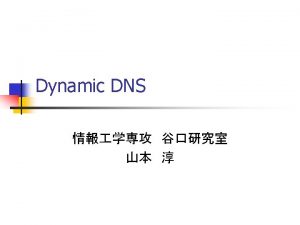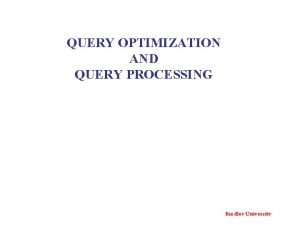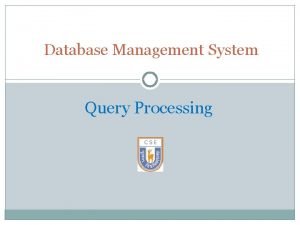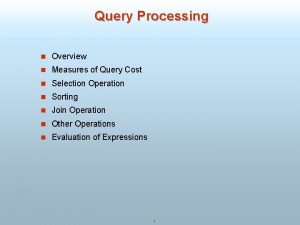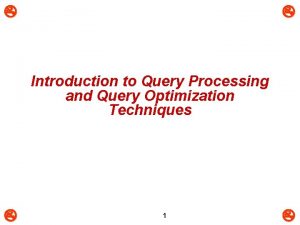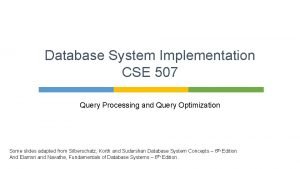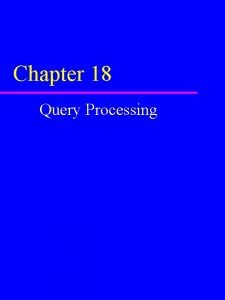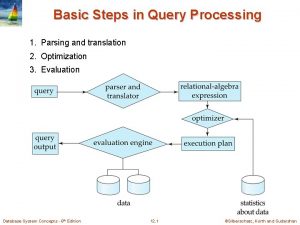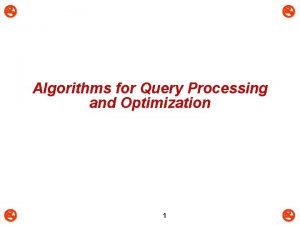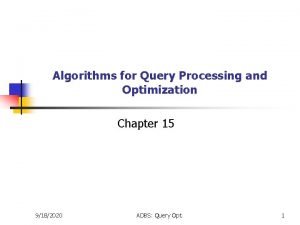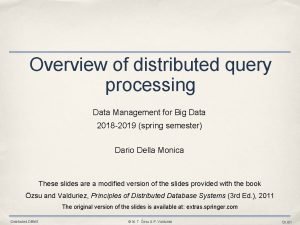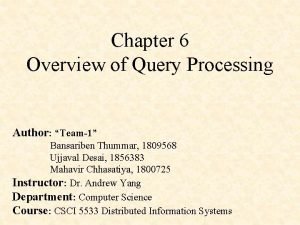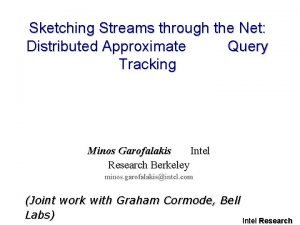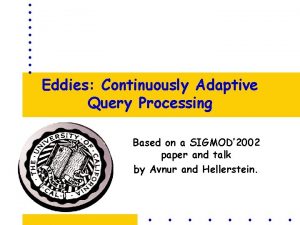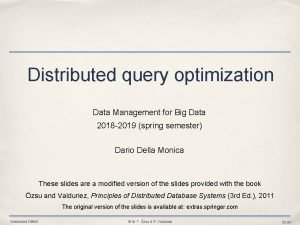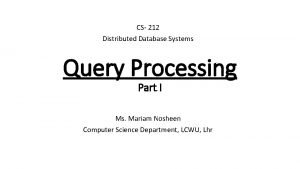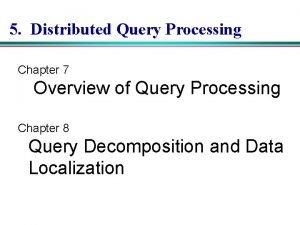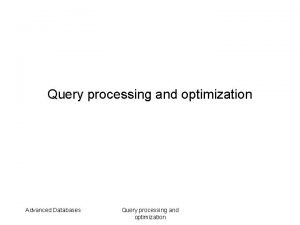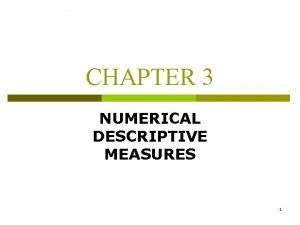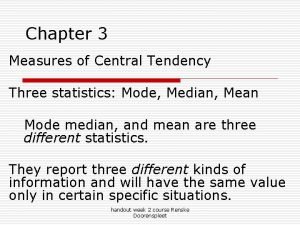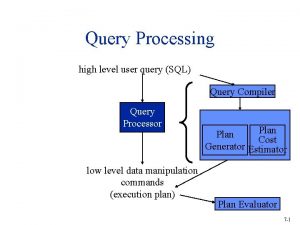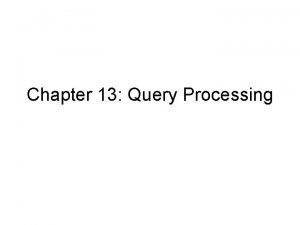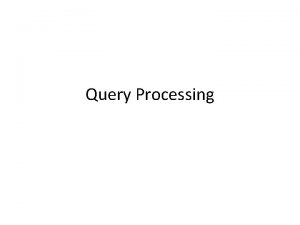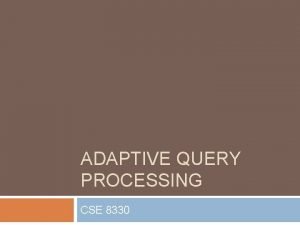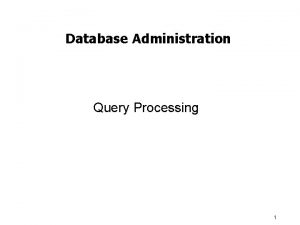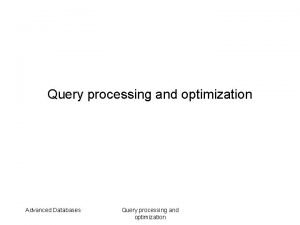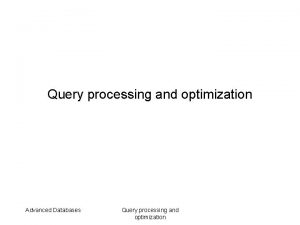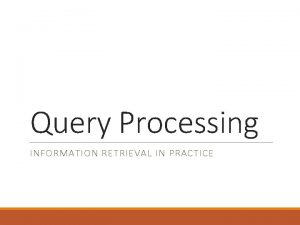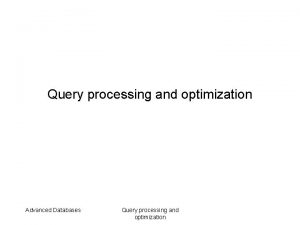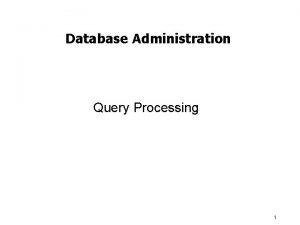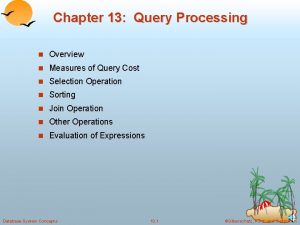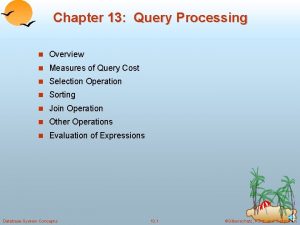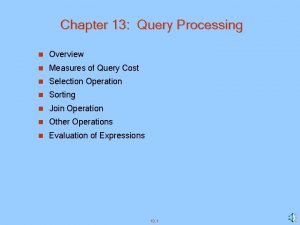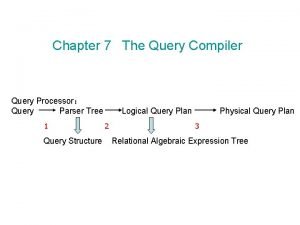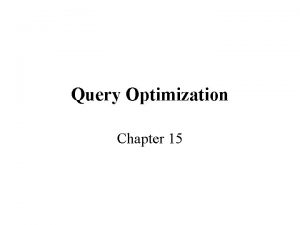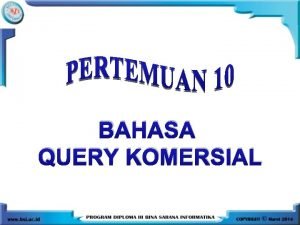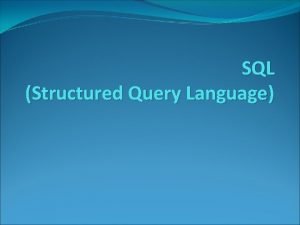Chapter 13 Query Processing n Overview n Measures


















































- Slides: 50

Chapter 13: Query Processing n Overview n Measures of Query Cost n Selection Operation n Sorting n Join Operation n Other Operations n Evaluation of Expressions Database System Concepts 13. 1 ©Silberschatz, Korth and Sudarshan

Basic Steps in Query Processing 1. Parsing and translation 2. Optimization 3. Evaluation Database System Concepts 13. 2 ©Silberschatz, Korth and Sudarshan

Parsing, Translation and Evaluation n Parsing and translation: Ø Checks syntax, verifies relations, attributes, etc. Ø Translates the query into its internal form, which is then translated into relational algebra. n Evaluation: Ø Executes the (chosen) query-evaluation plan. Ø Returns results. Database System Concepts 13. 3 ©Silberschatz, Korth and Sudarshan

Optimization n Observation #1: A given relational algebra expression has many equivalent expressions: balance 2500( balance(account)) balance( balance 2500(account)) n Observation #2: Each relational algebraic operation can be evaluated using one of several different algorithms: Ø Could use an index on balance to find accounts with balance < 2500, or perform complete relation scan and discard accounts with balance 2500 n Thus a relational-algebra expression can be evaluated in many ways. n Annotated expression specifying detailed evaluation strategy is called an evaluation-plan (also called a query execution plan, query plan, etc). Database System Concepts 13. 4 ©Silberschatz, Korth and Sudarshan

Basic Steps: Optimization (Cont. ) n Query Optimization: Amongst all equivalent evaluation plans choose the one with lowest cost. Ø Estimated using statistical information from the database catalog. è number of tuples in each relation, size of tuples, etc. n This chapter (13) covers: Ø How to measure query cost. Ø Algorithms for individual relational algebra operations. Ø How to combine algorithms for individual operations in order to evaluate a complete expression. n The next chapter (14) covers: Ø We study how to optimize queries, that is, how to find an evaluation plan with lowest estimated cost. Database System Concepts 13. 5 ©Silberschatz, Korth and Sudarshan

Measures of Query Cost n Cost is generally defined as total elapsed time for query execution. n Many factors contribute to time cost: Ø disk accesses Ø CPU time Ø network communication Ø Sequential vs. random I/O n Typically disk access is the predominant cost, and is also relatively easy to estimate. n Disk access time is comprised of: Ø Number of disk seeks * average-seek-time Ø Number of blocks read * average-block-read-time Ø Number of blocks written * average-block-write-time è Cost to write a block is greater than cost to read a block because data is read back after being written to ensure that the write was successful. Database System Concepts 13. 6 ©Silberschatz, Korth and Sudarshan

Measures of Query Cost (Cont. ) n For simplicity we just use number of block transfers to/from disk as the cost measure, and we ignore all other factors. Ø Real DBMSs take these factors into account. n Cost depends on the size of the buffer in main memory: Ø Having more memory reduces need for disk access n Amount of memory available for the buffer depends on other concurrent OS processes, and is therefore hard to determine before execution time: Ø We often use worst case estimates, assuming only the minimum amount of memory is available for query execution. n We do not include cost to writing output to disk in our cost formulae. Database System Concepts final output 13. 7 ©Silberschatz, Korth and Sudarshan

Selection Operation n File scan – search algorithms that locate and retrieve records that fulfill a selection condition, without using an index. n Algorithm A 1 (linear search). Scan each file block and test all records to see whether they satisfy the selection condition. Ø Cost estimate (number of disk blocks scanned) = br è br denotes number of blocks containing records from relation r Ø If selection is on a key attribute, cost = (br /2) è stop on finding record Ø Linear search can be applied regardless of For an arbitrary predicate, this is best, worst and average case. è selection condition or è ordering of records in the file, or è availability of indices This is average case. n Note that linear search is sometimes referred to as a table scan or a file scan, although the latter term includes other algorithms. Database System Concepts 13. 8 ©Silberschatz, Korth and Sudarshan

Selection Operation (Cont. ) n A 2 (binary search). Applicable if selection is an equality comparison on the attribute on which file is ordered. Ø Assume that the blocks of a relation are stored contiguously Ø Cost estimate (number of disk blocks to be scanned): è log 2(br) — cost of locating the first tuple by a binary search on the blocks. è Plus number of blocks containing records that satisfy selection condition. – Will see how to estimate this cost in Chapter 14 Database System Concepts 13. 9 ©Silberschatz, Korth and Sudarshan

Selections Using Indices n Index scan – search algorithms that use an index Ø selection condition must be on search-key of index. n A 3 (primary index on candidate key, equality). Retrieve a single record that satisfies the corresponding equality condition. Ø Cost = HTi + 1 n A 4 (primary index on nonkey, equality) Retrieve multiple records. Ø Records will be on consecutive blocks. Ø Cost = HTi + number of blocks containing retrieved records. Database System Concepts 13. 10 ©Silberschatz, Korth and Sudarshan

Selections Using Indices n A 5 (equality on search-key of secondary index). Ø Retrieve a single record if the search-key is a candidate key. è Cost = HTi + 1 Ø Retrieve multiple records if search-key is not a candidate key. è Cost = HTi + number of records retrieved – Can be very expensive! è Each record may be on a different block. – One block access for each retrieved record. Database System Concepts 13. 11 ©Silberschatz, Korth and Sudarshan

Selections Involving Comparisons n Can implement selections of the form A V (r) or A V(r) by using Ø File Scan - linear or binary search (if sorted). Ø Index Scan - using indices as specified in the following. n A 6 (primary index, comparison). è For A V(r) use index to find first tuple v and scan relation sequentially from there. è For A V (r) scan relation sequentially until first tuple > v; do not use index. n A 7 (secondary index, comparison). è For A V(r) use index to find first index entry v and scan index sequentially from there, to find pointers to records. è For A V (r) scan leaf pages of index using pointers to records, until reaching first entry > v. è Either case requires an I/O for each record, worst case. è Linear search may be cheaper if many records are to be fetched! Database System Concepts 13. 12 ©Silberschatz, Korth and Sudarshan

Implementation of Complex Selections n Conjunction: 1 2. . . n(r) n A 8 (conjunctive selection using one index). Ø Select one of the conditions i and algorithms A 1 through A 7 that results in the least cost for i (r). Ø Test other conditions on tuples after fetching them into the memory buffer. n A 9 (conjunctive selection using multiple-key index). Ø Use appropriate composite (multiple-key) index if available. n A 10 (conjunctive selection by intersection of identifiers). Ø Requires indices with record pointers. Ø Use corresponding index for each condition, and take intersection of all the obtained sets of record pointers, and then fetch records from data file. Ø If some conditions do not have appropriate indices, apply test in memory. Database System Concepts 13. 13 ©Silberschatz, Korth and Sudarshan

Algorithms for Complex Selections n Disjunction: 1 2 . . . n (r). n A 11 (disjunctive selection by union of identifiers). Ø Use corresponding index for each condition, and take union of all the obtained sets of record pointers, and then fetch records from data file. Ø Applicable only if all conditions have available indices. è Otherwise use linear scan. n Negation: (r) Ø Use linear search. Ø If very few records satisfy , and an index is applicable to , find satisfying records using index and fetch from the data file (? ? !!). Database System Concepts 13. 14 ©Silberschatz, Korth and Sudarshan

B+ Tree Sorting n We may build an index on the relation, and then use the index to read the relation in sorted order. May lead to one disk block access for each tuple. How? n For relations that fit in memory, techniques like quicksort can be used. For relations that don’t fit in memory, external sort-merge is a good choice. Database System Concepts 13. 15 ©Silberschatz, Korth and Sudarshan

External Sort-Merge Let M denote memory size (in pages). 1. Create sorted runs. Let i be 0 initially. Repeatedly do the following till the end of the relation: (a) Read M blocks of relation into memory (b) Sort the in-memory blocks (c) Write sorted data to run Ri; increment i Let the final value of i be N 2. Merge the runs (N-way merge). We assume (for now) that N < M. 1. Use N blocks of memory to buffer input runs, and 1 block to buffer output. Read the first block of each run into its buffer page 2. repeat 1. Select the first record (in sort order) among all buffer pages 2. Write the record to the output buffer block; if the block is full write it to disk 3. Delete the record from its input buffer block. If the buffer block becomes empty then read the next block (if any) of the run into the buffer. 3. until all input buffer blocks are empty: Database System Concepts 13. 16 ©Silberschatz, Korth and Sudarshan

External Sort-Merge (Cont. ) n If i M, several merge passes are required. Ø In each pass, contiguous groups of M - 1 runs are merged. Ø A pass reduces the number of runs by a factor of M -1, and creates runs longer by the same factor. è E. g. If M=11, and there are 90 runs, one pass reduces the number of runs to 9, each 10 times the size of the initial runs. Ø Repeated passes are performed till all runs have been merged into one. Database System Concepts 13. 17 ©Silberschatz, Korth and Sudarshan

Example: External Sorting Using Sort-Merge M=3 R 0 R 1 R 2 R 3 Database System Concepts 13. 18 ©Silberschatz, Korth and Sudarshan

External Merge Sort (Cont. ) n Cost analysis: Ø Total number of merge passes required: log. M– 1(br/M). Ø Disk accesses for initial run creation as well as in each pass is 2 br è For final pass, we ignore final write cost for all operations since the output of an operation may be sent to the parent operation without being written to disk Thus total number of disk accesses for external sorting: br ( 2 log. M– 1(br / M) + 1) Database System Concepts 13. 19 ©Silberschatz, Korth and Sudarshan

Join Operation n Several different algorithms to implement joins Ø Nested-loop join Ø Block nested-loop join Ø Indexed nested-loop join Ø Merge-join Ø Hash-join n Choice based on cost estimate n Examples use the following information Ø Number of records of customer: 10, 000 depositor: 5000 Ø Number of blocks of customer: depositor: 100 Database System Concepts 13. 20 400 ©Silberschatz, Korth and Sudarshan

Nested-Loop Join n To compute theta join r s for each tuple tr in r do begin for each tuple ts in s do begin test pair (tr, ts) to see if they satisfy the join condition if they do, add tr • ts to the result. end n r is called the outer relation and s the inner relation of the join. n Requires no indices and can be used with any kind of join condition. n Expensive since it examines every pair of tuples in the two relations. Database System Concepts 13. 21 ©Silberschatz, Korth and Sudarshan

Nested-Loop Join (Cont. ) n In the worst case, if there is enough memory only to hold one block of each relation, the estimated cost is nr bs + b r disk accesses. n If the smaller relation fits entirely in memory, use that as the inner relation. Reduces cost to br + bs disk accesses. n Assuming worst case memory availability cost estimate is Ø 5000 400 + 100 = 2, 000, 100 disk accesses with depositor as 10000 outer relation, and Ø 1000 100 + 400 = 1, 000, 400 disk accesses with customer as the outer relation. n If smaller relation (depositor) fits entirely in memory, the cost estimate will be 500 disk accesses. n Block nested-loops algorithm (next slide) is preferable. Database System Concepts 13. 22 ©Silberschatz, Korth and Sudarshan

Block Nested-Loop Join n Variant of nested-loop join in which every block of inner relation is paired with every block of outer relation. for each block Br of r do begin for each block Bs of s do begin for each tuple tr in Br do begin for each tuple ts in Bs do begin Check if (tr, ts) satisfy the join condition if they do, add tr • ts to the result. end end Database System Concepts 13. 23 ©Silberschatz, Korth and Sudarshan

Block Nested-Loop Join (Cont. ) n Worst case estimate: br bs + br block accesses. Ø Each block in the inner relation s is read once for each block in the outer relation (instead of once for each tuple in the outer relation n Best case: br + bs block accesses. n Improvements to nested loop and block nested loop algorithms: Ø In block nested-loop, use M — 2 disk blocks as blocking unit for outer relations, where M = memory size in blocks; use remaining two blocks to buffer inner relation and output è Cost = br / (M-2) bs + br This isloop worston case, Ø If equi-join attribute forms a key or inner relation, stop inner first best case is still the same. match Ø Scan inner loop forward and backward alternately, to make use of the blocks remaining in buffer (with LRU replacement) Ø Use index on inner relation if available (next slide) Database System Concepts 13. 24 ©Silberschatz, Korth and Sudarshan

Indexed Nested-Loop Join n Index lookups can replace file scans if Ø join is an equi-join or natural join and Ø an index is available on the inner relation’s join attribute è Can construct an index just to compute a join. n For each tuple tr in the outer relation r, use the index to look up tuples in s that satisfy the join condition with tuple tr. n Worst case: buffer has space for only one page of r, and, for each tuple in r, we perform an index lookup on s. Worst case will assume index blocks are not in buffer, best case will assume that some are (perhaps close to br+bs if index is pinned in buffer? ) n Cost of the join: br + nr c Ø Where c is the cost of traversing index and fetching all matching s tuples for one tuple or r Ø c can be estimated as cost of a single selection on s using the join condition. n If indices are available on join attributes of both r and s, use the relation with fewer tuples as the outer relation. Database System Concepts 13. 25 ©Silberschatz, Korth and Sudarshan

Example of Nested-Loop Join Costs n Compute depositor customer, with depositor as the outer relation. n Let customer have a primary B+-tree index on the join attribute customer-name, which contains 20 entries in each index node. n Since customer has 10, 000 tuples, the height of the tree is 4, and one more access is needed to find the actual data n depositor has 5000 tuples 100*400+100 n Cost of block nested loops join Ø 400*100 + 100 = 40, 100 disk accesses assuming worst case memory (may be significantly less with more memory) n Worst case Cost of indexed nested loops join Ø 100 + 5000 * 5 = 25, 100 disk accesses. Ø CPU cost likely to be less than that for block nested loops join Database System Concepts 13. 26 ©Silberschatz, Korth and Sudarshan

Merge-Join 1. Sort both relations on their join attribute (if not already sorted on the join attributes). 2. Merge the sorted relations to join them 1. Join step is similar to the merge stage of the sort-merge algorithm. 2. Main difference is handling of duplicate values in join attribute — every pair with same value on join attribute must be matched 3. Detailed algorithm in book Database System Concepts 13. 27 ©Silberschatz, Korth and Sudarshan

Merge-Join (Cont. ) n Can be used only for equi-joins and natural joins n Each block needs to be read only once (assuming all tuples for any given value of the join attributes fit in memory n Thus number of block accesses for merge-join is Worst case br + bs + Best case is min(bs, br) + 1 + cost of sorting the cost of sorting if relations are unsorted. n hybrid merge-join: If one relation is sorted, and the other has a secondary B+-tree index on the join attribute Ø Merge the sorted relation with the leaf entries of the B+-tree. Ø Sort the result on the addresses of the unsorted relation’s tuples Ø Scan the unsorted relation in physical address order and merge with Not really a “scan” of the whole relation. previous result, to replace addresses by the actual tuples è Sequential scan more efficient than random lookup Database System Concepts 13. 28 ©Silberschatz, Korth and Sudarshan

Hash-Join n Applicable for equi-joins and natural joins. n A hash function h is used to partition tuples of both relations n h maps Join. Attrs values to {0, 1, . . . , n}, where Join. Attrs denotes the common attributes of r and s used in the natural join. Ø r 0, r 1, . . . , rn denote partitions of r tuples Why not n-1? è Each tuple tr r is put in partition ri where i = h(tr [Join. Attrs]). Ø r 0, , r 1. . . , rn denotes partitions of s tuples è Each tuple ts s is put in partition si, where i = h(ts [Join. Attrs]). n Note: In book, ri is denoted as Hri, si is denoted as Hsi and n is denoted as nh. Database System Concepts 13. 29 ©Silberschatz, Korth and Sudarshan

Hash-Join (Cont. ) Database System Concepts 13. 30 ©Silberschatz, Korth and Sudarshan

Hash-Join (Cont. ) n r tuples in ri need only to be compared with s tuples in si Need not be compared with s tuples in any other partition, since: Ø an r tuple and an s tuple that satisfy the join condition will have the same value for the join attributes. Ø If that value is hashed to some value i, the r tuple has to be in ri and the s tuple in si. Database System Concepts 13. 31 ©Silberschatz, Korth and Sudarshan

Hash-Join Algorithm The hash-join of r and s is computed as follows. 1. Partition the relation s using hashing function h. When partitioning a relation, one block of memory is reserved as the output buffer for each partition. A simplified version of the algorithm would simply read si into memory (the buffer), and then read in tuples from ri, one at a time. 2. Partition r similarly. 3. For each i: (a)Load si into memory and build an in-memory hash index on it using the join attribute. This hash index uses a different hash function than the earlier one h. (b)Read the tuples in ri from the disk one by one. For each tuple tr locate each matching tuple ts in si using the in-memory hash index. Output the concatenation of their attributes. Relation s is called the build input and r is called the probe input. Database System Concepts 13. 32 ©Silberschatz, Korth and Sudarshan

Hash-Join algorithm (Cont. ) n The value n and the hash function h is chosen such that each si should fit in memory. Ø Typically n is chosen as bs/M * f where f is a “fudge factor”, typically around 1. 2 Should be ri Ø The probe relation partitions si need not fit in memory n Recursive partitioning required if number of partitions n is The above technique greater than number of pages M of memory. could give you too Ø instead of partitioning n ways, use M – 1 partitions for s many partitions. Ø Further partition the M – 1 partitions using a different hash function Ø Use same partitioning method on r Ø Rarely required: e. g. , recursive partitioning not needed for relations of 1 GB or less with memory size of 2 MB, with block size of 4 KB. M > bs/M * f which roughly simplifies to: M > square root of bs Database System Concepts 13. 33 ©Silberschatz, Korth and Sudarshan

Handling of Overflows n Hash-table overflow occurs in partition si if si does not fit in n n memory. Reasons could be Ø Many tuples in s with same value for join attributes Ø Bad hash function Partitioning is said to be skewed if some partitions have significantly more tuples than some others Overflow resolution can be done in build phase Ø Partition si is further partitioned using different hash function. Ø Partition ri must be similarly partitioned. Overflow avoidance performs partitioning carefully to avoid overflows during build phase Ø E. g. partition build relation into many partitions, then combine them Both approaches fail with large numbers of duplicates Ø Fallback option: use block nested loops join on overflowed partitions Database System Concepts 13. 34 ©Silberschatz, Korth and Sudarshan

Cost of Hash-Join n If recursive partitioning is not required: cost of hash join is 3(br + bs) +2 nh n If recursive partitioning required, number of passes required for partitioning s is log. M– 1(bs) – 1. This is because each final partition of s should fit in memory. n The number of partitions of probe relation r is the same as that for build relation s; the number of passes for partitioning of r is also the same as for s. n Therefore it is best to choose the smaller relation as the build relation. n Total cost estimate is: 2(br + bs log. M– 1(bs) – 1 + br + bs n If the entire build input can be kept in main memory, n can be set to 0 and the algorithm does not partition the relations into temporary files. Cost estimate goes down to br + bs. Database System Concepts 13. 35 ©Silberschatz, Korth and Sudarshan

Example of Cost of Hash-Join customer depositor n Assume that memory size is 20 blocks n bdepositor= 100 and bcustomer = 400. n depositor is to be used as build input. Partition it into five partitions, each of size 20 blocks. This partitioning can be done in one pass. n Similarly, partition customer into five partitions, each of size 80. This is also done in one pass. n Therefore total cost: 3(100 + 400) = 1500 block transfers Ø ignores cost of writing partially filled blocks Database System Concepts 13. 36 ©Silberschatz, Korth and Sudarshan

Hybrid Hash–Join n Useful when memory sized are relatively large, and the build input is bigger than memory. n Main feature of hybrid hash join: Keep the first partition of the build relation in memory. n E. g. With memory size of 25 blocks, depositor can be partitioned into five partitions, each of size 20 blocks. n Division of memory: Ø The first partition occupies 20 blocks of memory Ø 1 block is used for input, and 1 block each for buffering the other 4 partitions. n customer is similarly partitioned into five partitions each of size 80; the first is used right away for probing, instead of being written out and read back. n Cost of 3(80 + 320) + 20 +80 = 1300 block transfers for hybrid hash join, instead of 1500 with plain hash-join. n Hybrid hash-join most useful if M >> Database System Concepts 13. 37 ©Silberschatz, Korth and Sudarshan

Complex Joins n Join with a conjunctive condition: r 1 2. . . n s Ø Either use nested loops/block nested loops, or Ø Compute the result of one of the simpler joins r i s è final result comprises those tuples in the intermediate result that satisfy the remaining conditions 1 . . . i – 1 i +1 . . . n n Join with a disjunctive condition r 1 2 . . . n s Ø Either use nested loops/block nested loops, or Ø Compute as the union of the records in individual joins r s: (r Database System Concepts 1 s) (r 2 s) . . . (r 13. 38 n i s) ©Silberschatz, Korth and Sudarshan

Other Operations n Duplicate elimination can be implemented via hashing or sorting. Ø On sorting duplicates will come adjacent to each other, and all but one set of duplicates can be deleted. Optimization: duplicates can be deleted during run generation as well as at intermediate merge steps in external sort-merge. Ø Hashing is similar – duplicates will come into the same bucket. n Projection is implemented by performing projection on each tuple followed by duplicate elimination. Database System Concepts 13. 39 ©Silberschatz, Korth and Sudarshan

Other Operations : Aggregation n Aggregation can be implemented in a manner similar to duplicate elimination. Ø Sorting or hashing can be used to bring tuples in the same group together, and then the aggregate functions can be applied on each group. Ø Optimization: combine tuples in the same group during run generation and intermediate merges, by computing partial aggregate values è For count, min, max, sum: keep aggregate values on tuples found so far in the group. – When combining partial aggregate for count, add up the aggregates è For avg, keep sum and count, and divide sum by count at the end Database System Concepts 13. 40 ©Silberschatz, Korth and Sudarshan

Other Operations : Set Operations n Set operations ( , and ): can either use variant of merge-join after sorting, or variant of hash-join. n E. g. , Set operations using hashing: 1. Partition both relations using the same hash function, thereby creating, r 1, . . , rn r 0, and s 1, s 2. . , sn 2. Process each partition i as follows. Using a different hashing function, build an in-memory hash index on ri after it is brought into memory. Why bother? Duplicates! 3. – r s: Add tuples in si to the hash index if they are not already in it. At end of si add the tuples in the hash index to the result. – r s: output tuples in si to the result if they are already there in the hash index. – r – s: for each tuple in si, if it is there in the hash index, delete it from the index. At end of si add remaining tuples in the hash index to the result. Database System Concepts 13. 41 ©Silberschatz, Korth and Sudarshan

Other Operations : Outer Join n Outer join can be computed either as Ø A join followed by addition of null-padded non-participating tuples. Ø by modifying the join algorithms. n Modifying merge join to compute r Ø In r s s, non participating tuples are those in r – R(r s) Ø Modify merge-join to compute r s: During merging, for every tuple tr from r that do not match any tuple in s, output tr padded with nulls. Ø Right outer-join and full outer-join can be computed similarly. n Modifying hash join to compute r s Ø If r is probe relation, output non-matching r tuples padded with nulls Ø If r is build relation, when probing keep track of which r tuples matched s tuples. At end of si output non-matched r tuples padded with nulls Database System Concepts 13. 42 ©Silberschatz, Korth and Sudarshan

Evaluation of Expressions n So far: we have seen algorithms for individual operations n Alternatives for evaluating an entire expression tree Ø Materialization: generate results of an expression whose inputs are relations or are already computed, and store then on disk. Repeat for all operations. Ø Pipelining: pass tuples output by one operation to the next (parent) operations (as input) even as the first operation is being execute. Database System Concepts 13. 43 ©Silberschatz, Korth and Sudarshan

Materialization n Materialized evaluation: evaluate one operation at a time, starting at the lowest-level. Use intermediate results materialized into temporary relations to evaluate nextlevel operations. n E. g. , in figure below, compute and store then compute the store its join with customer, and finally compute the projections on customer-name. Database System Concepts 13. 44 ©Silberschatz, Korth and Sudarshan

Materialization (Cont. ) n Materialized evaluation is always applicable n Cost of writing results to disk and reading them back can be quite high Ø Our cost formulas for operations ignore cost of writing results to disk, so è Overall cost = Sum of costs of individual operations + cost of writing intermediate results to disk n Double buffering: use two output buffers for each operation, when one is full write it to disk while the other is getting filled Ø Allows overlap of disk writes with computation and reduces execution time Database System Concepts 13. 45 ©Silberschatz, Korth and Sudarshan

Pipelining n Evaluate several operations simultaneously, passing the results of one operation on to the next. n E. g. , in previous expression tree, don’t store (materialize) result of Ø instead, pass tuples directly to the join. Similarly, don’t store result of join, pass tuples directly to projection. n Much cheaper than materialization: no need to store a temporary relation to disk. n Pipelining may not always be possible – e. g. , sort, hash-join. n For pipelining to be effective, use evaluation algorithms that generate output tuples even as tuples are received for inputs to the operation. n Pipelines can be executed in two ways: demand driven and producer driven. Database System Concepts 13. 46 ©Silberschatz, Korth and Sudarshan

Pipelining (Cont. ) n In demand driven or lazy evaluation Ø system repeatedly requests next tuple from top level operation Ø Each operation requests next tuple from children operations as required, in order to output its next tuple Ø In between calls, operation has to maintain “state” so it knows what to return next Ø Each operation is implemented as an iterator implementing the following operations è open() – E. g. file scan: initialize file scan, store pointer to beginning of file as state – E. g. merge join: sort relations and store pointers to beginning of sorted relations as state è next() – E. g. for file scan: Output next tuple, and advance and store file pointer – E. g. for merge join: continue with merge from earlier state till next output tuple is found. Save pointers as iterator state. è close() Database System Concepts 13. 47 ©Silberschatz, Korth and Sudarshan

Pipelining (Cont. ) n In produce-driven or eager pipelining Ø Operators produce tuples eagerly and pass them up to their parents è Buffer maintained between operators, child puts tuples in buffer, parent removes tuples from buffer è if buffer is full, child waits till there is space in the buffer, and then generates more tuples Ø System schedules operations that have space in output buffer and can process more input tuples Database System Concepts 13. 48 ©Silberschatz, Korth and Sudarshan

Evaluation Algorithms for Pipelining n Some algorithms are not able to output results even as they get input tuples Ø E. g. merge join, or hash join Ø These result in intermediate results being written to disk and then read back always n Algorithm variants are possible to generate (at least some) results on the fly, as input tuples are read in Ø E. g. hybrid hash join generates output tuples even as probe relation tuples in the in-memory partition (partition 0) are read in Ø Pipelined join technique: Hybrid hash join, modified to buffer partition 0 tuples of both relations in-memory, reading them as they become available, and output results of any matches between partition 0 tuples è When a new r 0 tuple is found, match it with existing s 0 tuples, output matches, and save it in r 0 è Symmetrically for s 0 tuples Database System Concepts 13. 49 ©Silberschatz, Korth and Sudarshan

Complex Joins n Join involving three relations: loan n Strategy 1. Compute depositor customer; use result to compute loan (depositor customer) n Strategy 2. Computer loan depositor first, and then join the result with customer. n Strategy 3. Perform the pair of joins at once. Build and index on loan for loan-number, and on customer for customer-name. Ø For each tuple t in depositor, look up the corresponding tuples in customer and the corresponding tuples in loan. Ø Each tuple of deposit is examined exactly once. n Strategy 3 combines two operations into one special-purpose operation that is more efficient than implementing two joins of two relations. Database System Concepts 13. 50 ©Silberschatz, Korth and Sudarshan
 Iterative query
Iterative query Query tree and query graph
Query tree and query graph Query tree and query graph
Query tree and query graph Steps of query processing
Steps of query processing Repeated measures design vs independent measures design
Repeated measures design vs independent measures design Steps in query processing
Steps in query processing Query optimization steps
Query optimization steps Steps in query processing
Steps in query processing Objectives of query processing
Objectives of query processing Parsing and translation in query processing
Parsing and translation in query processing Steps in query processing
Steps in query processing Algorithms for query processing and optimization
Algorithms for query processing and optimization Distributed query processing
Distributed query processing Characteristics of query processor
Characteristics of query processor Sketch techniques for approximate query processing
Sketch techniques for approximate query processing What is the role of eddy in adaptive query processing
What is the role of eddy in adaptive query processing Distributed query processing
Distributed query processing Distributed query processing
Distributed query processing Distributed query processing
Distributed query processing Basic steps in query processing
Basic steps in query processing Sql server intelligent query processing
Sql server intelligent query processing Measures a module’s scope and processing characteristics.
Measures a module’s scope and processing characteristics. Top-down processing vs bottom-up processing
Top-down processing vs bottom-up processing Gloria suarez
Gloria suarez Bottom-up processing example
Bottom-up processing example Neighborhood processing in image processing
Neighborhood processing in image processing Primary processing of wheat
Primary processing of wheat What is point processing in digital image processing
What is point processing in digital image processing Histogram processing in digital image processing
Histogram processing in digital image processing Parallel processing vs concurrent processing
Parallel processing vs concurrent processing Nonlinear image processing
Nonlinear image processing Point processing
Point processing Digital image processing
Digital image processing Top down processing
Top down processing Batch processing vs interactive processing
Batch processing vs interactive processing Chapter 24 trauma overview
Chapter 24 trauma overview Emt chapter 14 medical overview
Emt chapter 14 medical overview Chapter 9 lesson 2 photosynthesis an overview
Chapter 9 lesson 2 photosynthesis an overview Chapter 12 selling overview
Chapter 12 selling overview Financial intermediaries
Financial intermediaries Chapter 1 overview of verb tenses
Chapter 1 overview of verb tenses Overview of personal finance chapter 1
Overview of personal finance chapter 1 Tooth numbering system in usa
Tooth numbering system in usa Foundations in personal finance chapter 1 review
Foundations in personal finance chapter 1 review Chapter 32 an overview of animal diversity
Chapter 32 an overview of animal diversity Chapter 1 an overview of financial management
Chapter 1 an overview of financial management Chapter 17 overview elements and their properties
Chapter 17 overview elements and their properties Chapter 1 overview of financial statement analysis
Chapter 1 overview of financial statement analysis Chapter 3 numerical descriptive measures
Chapter 3 numerical descriptive measures Statistics chapter 3 measures of central tendency
Statistics chapter 3 measures of central tendency My structured query language
My structured query language
